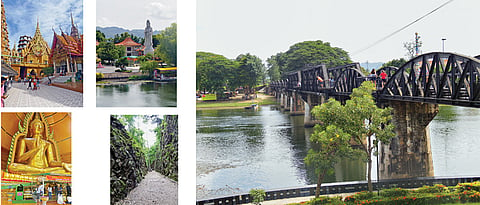

Among some unconventional destinations in Thailand which Indian and other tourists are now discovering, is the town of Kanchanaburi. The place is connected with highway and railway. The railway ride to it is very comfortable. Global tourists come to this place to visit the historic bridge. Known as the Bridge on the River Kwai, it is about 5 km from the centre of Kanchanaburi.
The bridge is now surrounded on the Kanchanaburi side by a museum, cafes, shops and a couple of stationary steam locomotives on display. You’re free to walk across the bridge on the wooden planks, but remember to stand aside for the passenger train when one comes along. If this sounds foolhardy, remember that there is a 10 km/h speed restriction for trains across the bridge, and they all hoot like mad.
The next destination worth visiting is the historic Hellfire pass, part of the railway route built during the Second World War. This was done with forced labour during the Second World War in part by prisoners of war or POW. This pass is noted for the harsh conditions and heavy loss of life suffered by its labourers during its construction.
Hellfire Pass is so called because the sight of emaciated prisoners labouring at night by torchlight was said to resemble a scene from Hellfire Pass in the Tennaserim hills. It was a particularly difficult section of the line to build. It was the largest rock cutting on the railway, coupled with its general remoteness and the lack of proper construction tools during building.
A tunnel would have been possible to build instead of a cutting, but this could only be constructed at the two ends at any one time, whereas the cutting could be constructed at all points simultaneously despite the excess effort required by the POWs. The Australian, British, Dutch and other allied Prisoners of War were required by the Japanese to work 18 hours a day to complete the cutting. Sixty-nine men were beaten to death by Japanese guards in the six weeks it took to build the cutting, and many more died from hunger.
The Hellfire Pass Memorial Museum and the preservation of the Hellfire Pass itself had its origins in 1983 when former Prisoner of War J G (Tom) Morris toured the area in Thailand and resolved to convince the Australian Government that portions of the Thai-Burma Death Railway should be preserved as a historical site. As a result of his efforts, the Snowy Mountains Engineering Corporation (SMEC) was commissioned in 1984 to make a survey of the railway to choose a suitable site. Jim Appleby, an SMEC engineer at the Khao Laem dam-site on the upper Kwai Noi, did much of the ground work and passed his reports to the Australian-Thai Chamber of Commerce in 1985.
These destinations are really memorable and give the tourist new insights into the history of Thailand. A tour of these unconventional Thai destinations is definitely worth your time and money!
